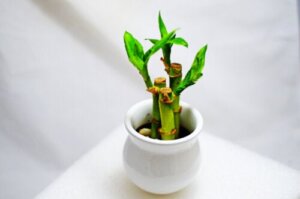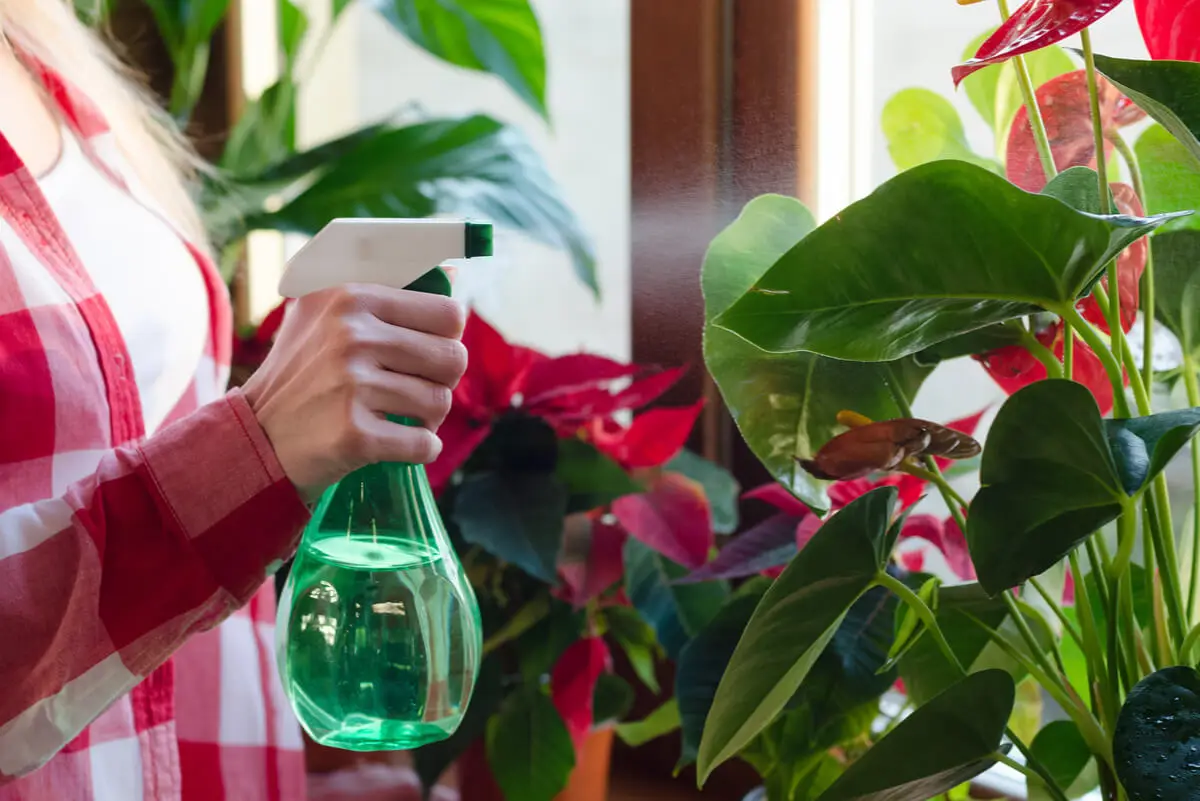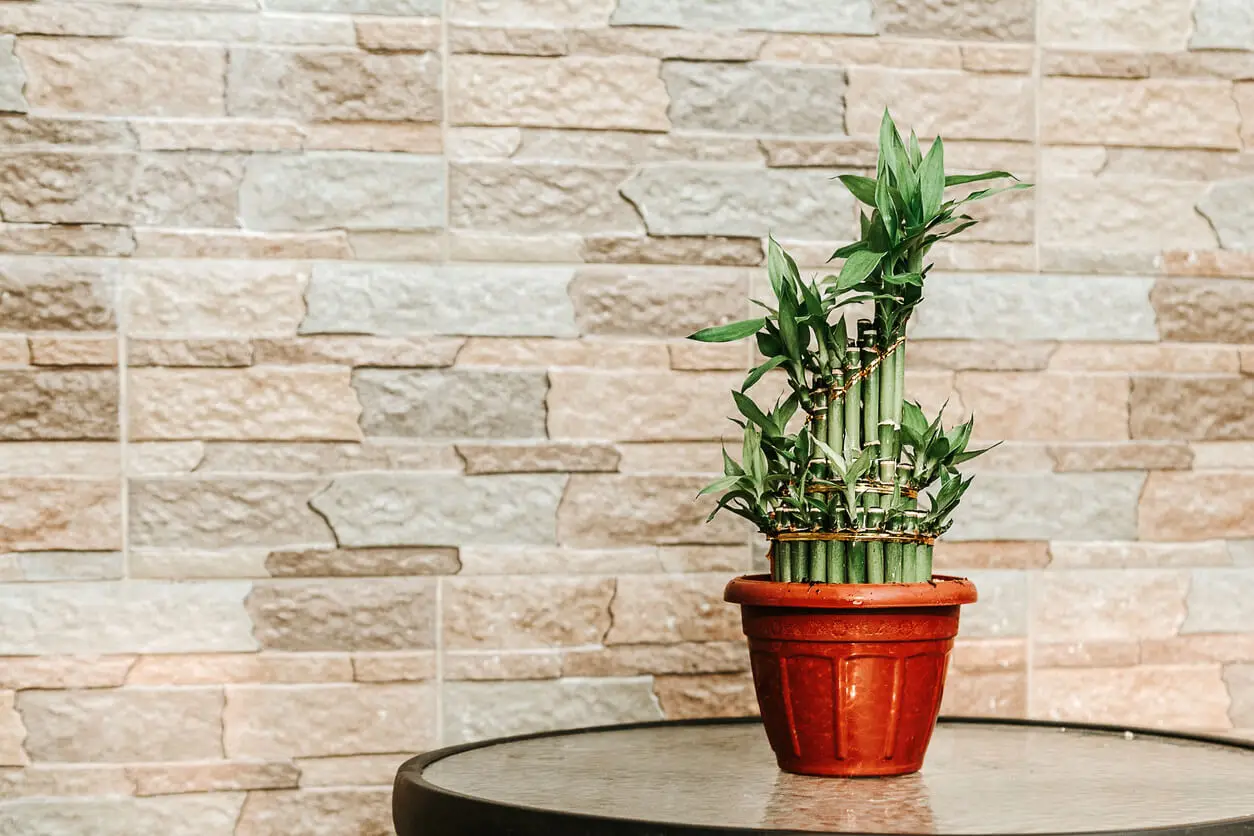Lucky Bamboo: Characteristics and Care

While lucky bamboo is a very easy-to-care-for plant, it’s important to follow some tips to keep it in good condition. We invite you to learn all about this wonderful and unique plant here!
Lucky bamboo: Main characteristics
Also known as lucky bamboo, the scientific name for this plant is Dracaena sanderiana. Its origins are found in areas with warm subtropical climates. This is a houseplant that prefers a location where it can receive moderate natural light.
It comes in the form of stems and has become popular among bamboo, although it’s actually a shoot of Dracaena sanderiana and is not related to them. What they do have in common is that they both grow in layers and you can find straight or spiral stems of varying sizes.
As for its structure, it consists of a straight rod from which shoots emerge and from which its roots develop.
Care of the lucky bamboo
It’s very simple to take care of one of these plants, only it’s essential to take into account issues of location and watering. The first thing to know is that it is an exclusively indoor plant and that it needs average natural light, but not direct sunlight.
Regarding the temperatures that best suit it, it reaches its fullness between 18°C and 24°C. If it goes down or up a little more, it is best to keep the temperature between 18°C and 24°C. If it goes down or up a little more, it won’t stand the thermal amplitudes either.
As for watering, it’s important to acquire a habit to make sure that the plant grows in a healthy way. In case you have it in water, you should change it once a week in winter and every 2 weeks in summer. At the same time, you have to steam the leaves twice a week to make sure that the foliage stays free of dust.
On the other hand, if you want to grow it in the ground, you have to water it when you notice that the substrate has lost moisture. In some cases, you can add a few drops of fertilizer once a month to help it grow.
What should you consider when choosing a specimen of this species? Check that the trunk is deep green and doesn’t have a yellowish hue. The roots should be rather light and the shoots should be green, abundant, and with a special shine.
We think you may also like to read: 8 Lucky Plants According to Feng Shui

How to transplant lucky bamboo
In case you want to transplant this plant, just choose a cutting that has leaves and place it in a container with filtered water. After a few weeks, you should notice new roots appearing.
In the meantime, the water should be changed regularly. When you notice that it has gained strength, you can place it next to the other stems.
Spiral lucky bamboo
This plant can grow in the form of a straight or curved rod. For the latter, the secret lies in leaving the plant exposed to only one direction of light, so that it’s directed straight at it.
You will need a box with a cutout. Cover the plant with the box, so that the light only enters through the cut you have made.
When you notice that the curve has formed, then you should turn the plant about 2 cm. It will then continue to grow more markedly.
Repeat this procedure with each new curve. You will just need a lot of patience, as it may take a little over a year to achieve the spiral.
Signs that your lucky bamboo has problems
As with any plant, it is common for some health problems to occur. In this sense, if you notice that the leaves have turned yellow, you should remove them immediately. Perhaps it’s been exposed to too much light or the water quality is not good, so we recommend watering with distilled water and adding a little fertilizer to replenish minerals and nutrients.
On the other hand, if the edges of the leaves turn brown, then you’re using too much fertilizer or the water isn’t filtering easily. Also, if the stem softens or turns brown, cut it and change the container.

The “Feng Shui” plant par excellence
Having explained its characteristics and special care, we will focus on the energy transmitted by this beautiful and simple plant. It’s said to attract prosperity, good luck, wealth, and good vibes.
On the other hand, Feng Shui has taken it as a symbol of fortune and as an activator of household energy. In this sense, the lucky bamboo would increase the positive energy or chi in the space where it’s placed. That’s why it may not be a bad idea to bring one of these plants to the office to remind you of the importance of this energy.
Remember that the philosophy of Feng Shui assigns a location for each element of the environment. In the case of this plant, its place is the east corner of the room, to call health and success in the professional field.
Now, why does this philosophy consider this plant to be so important? Well, it’s because we can find all 5 elements of nature represented in this plant:
- Wood: This is found in the plant itself.
- Earth: This is in stones that are commonly placed around it for decoration.
- Metal: Metal is found in the container or simply by adding a coin to the water.
- Water: This is the way to cultivate it.
- Fire: Fire is often incorporated with a red ribbon around the plant.
Finally, the number of bamboo stalks also holds meaning in aspects of life. For example, one stalk represents a simple life; two, double luck; three stalks, happiness, and longevity. So, the list goes on until it reaches 10 stalks, representing perfection.
21 stalks signifidies powerful blessings.
Like this article? You may also like: How to Make a Moss Guide or Support for Climbing Plants
Decorate your spaces with this plant
This plant is an excellent indoor companion that, in addition to decorating, brings good energy. They say that if you get it as a gift it will bring you good luck, but if you don’t receive one, you can give it to yourself and place it where you think you need it most.
Since it is a very easy-to-care-for plant, you don’t need to be a specialist to protect and grow your own lucky bamboo. So what are you waiting for? Give it a try!
All cited sources were thoroughly reviewed by our team to ensure their quality, reliability, currency, and validity. The bibliography of this article was considered reliable and of academic or scientific accuracy.
- Miguez Tapia, J. A. (2011). Propagación vegetativa del bambu ornamental (Dracaena sanderaina) mediante fitohormona(Bachelor’s thesis, Quevedo: UTEQ).
- Berraquero, B. O. (2017). FACULTAD DE FARMACIA (Doctoral dissertation, UNIVERSIDAD COMPLUTENSE).
- Daquinta, M., Rodríguez, D. P., Torrijo, F. S., & Más, Y. L. (2010). Propagación in vitro de bambú chino (Dracaena sanderiana L.). Ciencia y Tecnología, 3(1), 7-13.
- Vizcarra Arce, V. J. (2021). Evaluación de eficiencia en la reducción del hierro, manganeso y sulfatos contenidos en una muestra de aguas ácidas, tratada mediante un humedal de flujo sub superficial horizontal con la especie Dracaena sanderiana como componente vegetativo.
- Gradaille, M. D., Rodríguez, D. P., Más, Y. L., & Torrijo, F. S. (2010). PROPAGACIÓN IN VITRO DE BAMBÚ CHINO. Ciencia y Tecnología (1390-4051), 3(1).
- Koppel, M. (2006). Guía completa de feng shui(Vol. 199). Edaf.
This text is provided for informational purposes only and does not replace consultation with a professional. If in doubt, consult your specialist.








